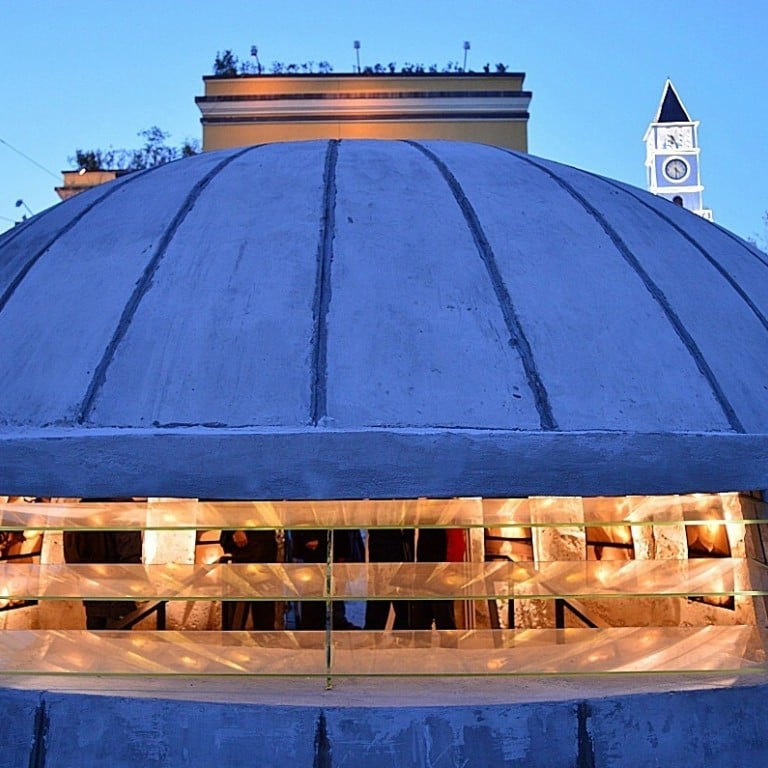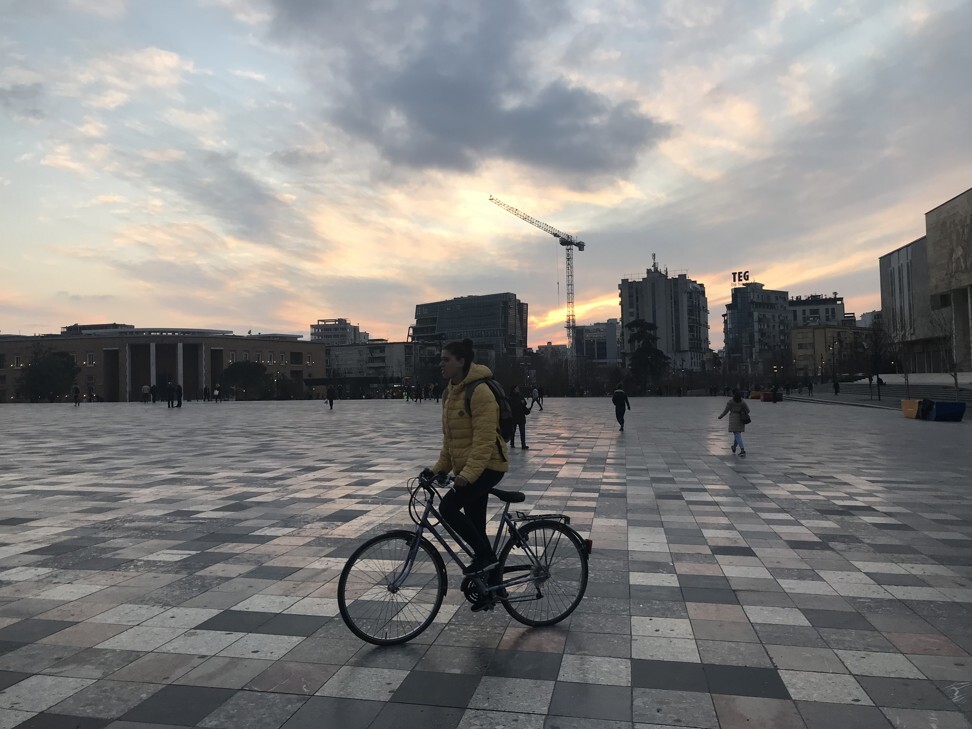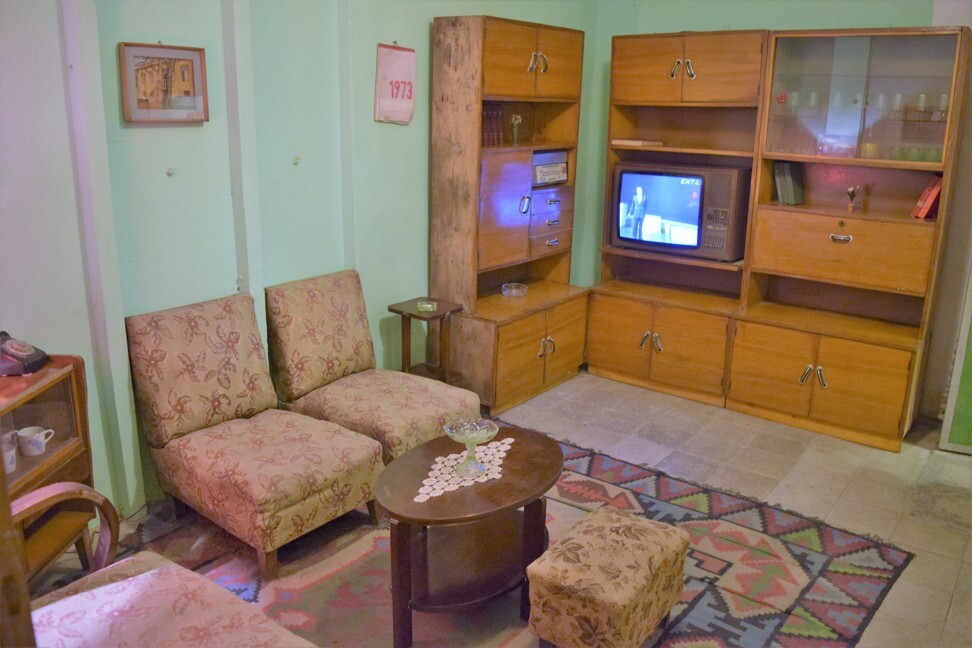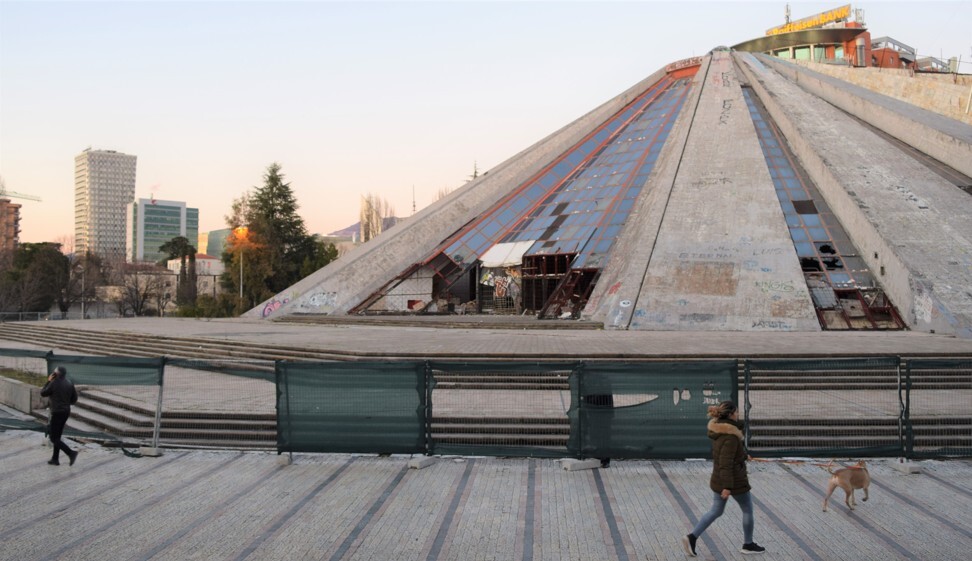
Dark tourism in Albania: ‘our suffering yesterday is your entertainment today’
- Former dictator Enver Hoxha’s nuclear shelter is among the landmarks that have been transformed into tourist attractions
- Two Bunk’Art museums have been accused on the Disneyfication of Albania’s post-war history
On a barren mountainside above the outskirts of Tirana, our footsteps echo ominously as we step through a series of airtight concrete and steel doorways, each many inches thick, and into a labyrinth of corridors that burrow deep into Mount Dajti.
Electric lights flicker, distant sirens moan, old desk telephones ring, and clipped, recorded voices drift up from the bowels of a once-secret five-storey subterranean complex created to save the skins of Albania’s ruling elite in the event of war, while everyone above is eviscerated in a mushroom cloud.
This vast, sinister compound 8km from the centre of the capital sucks visitors down into the bowels of the Earth and back in time – to an era when it was not fear of a pandemic that hovered uneasily in the national consciousness but an even more terrifying prospect: nuclear holocaust.
It is this harrowing history that Albania will be drawing on to entice tourists when they begin travelling again. The immense former nuclear bunkers in Tirana have been opened as visitor attractions, along with other macabre landmarks of the half-century of post-war tyranny and isolation that earned Albania the nickname “the North Korea of Europe”. Before the world locked down, I took a tour.

“Welcome to our horrible history,” our world-weary tour guide declares, with sardonic humour, as he drops us off at a complex that was once only whispered about by Tirana’s benighted residents, who lived in perpetual fear of arrest by the Sigurimi secret police. “Our suffering yesterday is your entertainment today.”
The grim “entertainment” comprises row upon row of windowless, square rooms creatively transformed into a surreal modernist museum using Cold War relics and photographs combined with light and sound to relate the extraordinary story of Albania’s descent into Kafkaesque insanity.
Some rooms are dedicated to the machinery of state and the primitive bugging apparatus used to catch out traitors, other rooms to the gulags where thousands of citizens perished, or to the daily lives of Albanians whose miserable socialist-era flats were fitted with the same selections of rudimentary appliances and cheap brown furniture to ensure everyone was equal. Except, of course, the elite.
The last of the former Eastern Bloc countries to abandon communism and one of Europe’s poorest countries, Albania still bears the scars of four decades of isolation under Enver Hoxha, 35 years after his death.
The dictator, once the leader of the country’s heroic wartime anti-fascist resistance, led his country on a path to ruin and isolation, falling out first with the Yugoslavs, then the Russians and finally the Chinese, until Albania was a hermit nation barely able to feed and clothe its people.
He made Albania a grim international laughing stock – a place where private cars were outlawed, beards and pop music were banned and churches were converted into sports halls as it declared itself the world’s first purely atheist state, in its own version of China’s Cultural Revolution.

Nearly all foreign television and films were banned, with the curious exception of British comic Norman Wisdom, whose on-screen antics with his boss, Mr Grimsdale, were viewed by Hoxha as a communist parable of the class struggle. Wisdom became an unlikely idol who was mobbed by fans, including the post-communist president Sali Berisha, on a 1995 visit.
But there was a far darker side to Hoxha’s paranoia. He sent tens of thousands of people to a network of brutal gulags and is rumoured to have shot dead one of his closest former allies, prime minister Mehmet Shehu, in front of colleagues at a Politburo meeting in 1981 after Shehu spoke out against isolationism.
In the last decade of his reign, convinced invasion was imminent, Hoxha ordered the building of 173,000 concrete bunkers across the impoverished country, one for every 11 citizens. These bunkers remain, like indestructible Dalek heads dotted incongruously on beaches, hillsides and the outskirts of farming villages.
The programme of “bunkerisation” drove Albania deeper into economic ruin. Each used as much concrete and as many materials as a two-bedroomed flat, and the finished monstrosities, with their machine-gun slots, were useless in the event of a nuclear attack. Instead, they were intended rather to let citizens take a heroic last stand against any foreign invaders.

Meanwhile Hoxha and his cronies would be safely tucked away in the bunker complex in Mount Dajti, with space inside for hundreds of family members and top officials. It even has a parliament hall at its centre, three storeys below ground, where Hoxha could have continued to deliver his decrees to any survivors as a nuclear winter raged above.
Albania eventually emerged blinking into the sunlight of freedom in late 1990, five years after Hoxha’s death, when the political prisons finally closed and the people were no longer shot as they tried to scramble over the mountains to mainland Greece or swim across the channel dividing Albania from Corfu.
Decades of isolation and indoctrination had taken their toll, however, and Albania struggled to come to terms with its past. Until a few years ago, you could visit Hoxha’s birthplace, in the southern city of Gjirokastër – once a place of national pilgrimage and now a folk museum – and buy communist-era hagiographies of the dictator from loyal elderly curators. Meanwhile, the post-war section of the National History Museum, in Tirana – now finally containing a display dedicated to the victims of the “communist terror” – stood empty and closed off as if the country were too busy accumulating wealth and stolen second-hand Mercedes smuggled in from Italy to take a backwards glance.
Both the Mount Dajti bunker and another, located three storeys beneath the notorious Ministry of Internal Affairs, in the centre of Tirana, have been converted into visitor attractions, called Bunk’Art 1 and Bunk’Art 2, respectively, to remember the Hoxha years.

In an initiative by Italian entrepreneur and broadcaster Carlo Bollini, supported by Albanian Prime Minister Edi Rama, the rooms of the bunkers have been filled with installations that make visiting them a surreal and unsettling experience. In Hoxha’s private quarters in Bunk’Art 1, visitors can pick up a phone and hear his voice. A portrait of him on the wall has been slashed with knives, showing the depth of emotion he still inspires from beyond the grave.
Bunk’Art manager Senada Murati says the bunkers were widely visited by Albanians when they were first opened to the public, in 2014. Since then, she says, most visitors have been foreigners. “We see both bunkers as important tourist attractions for Albanians and for tourists, too,” she says.
The transformation of the bunkers has proved controversial, with some critics accusing the curators of making light of, or even whitewashing, the worst of the communist regime’s crimes and failing to give enough recognition to the thousands of Albanians who were tortured and killed under Hoxha.
“Much of the history is glossed over and in some cases, the worst things that happened are ignored,” one Albanian visitor complained on TripAdvisor. Others have accused Bunk’Art of the Disneyfication of the country’s post-war history.

It is not just in the corridors of Bunk’Art that Albania is haunted by its past. It assails visitors in the bunkers that appear incongruously on the edge of every village and on every beach, some of them converted into cafes or painted in vivid graffiti, and in the decaying pyramid structure built in the heart of Tirana by Hoxha’s architect daughter, Pranvera.
The pyramid – said to have been the most expensive individual building ever constructed in Albania when it opened, in 1988 – was intended as a museum to honour Hoxha. It has since been used as a nightclub and a set for a horror movie, but has now fallen into disrepair, its walls covered in graffiti, although it is patrolled by security guards.
Nearby stands the sinister House of Leaves – a two-storey villa that was once the headquarters of the Sigurimi. In 2017, it was converted into a museum “dedicated to the innocent people who were spied on, arrested, prosecuted, convicted, and executed during the communist regime”, according to an inscription at its entrance.
At the opening ceremony, Rama said: “Remembrance is an unavoidable step to building the future.” For many Albanians, however, that act of remembrance involves reopening wounds that are still painfully fresh.

